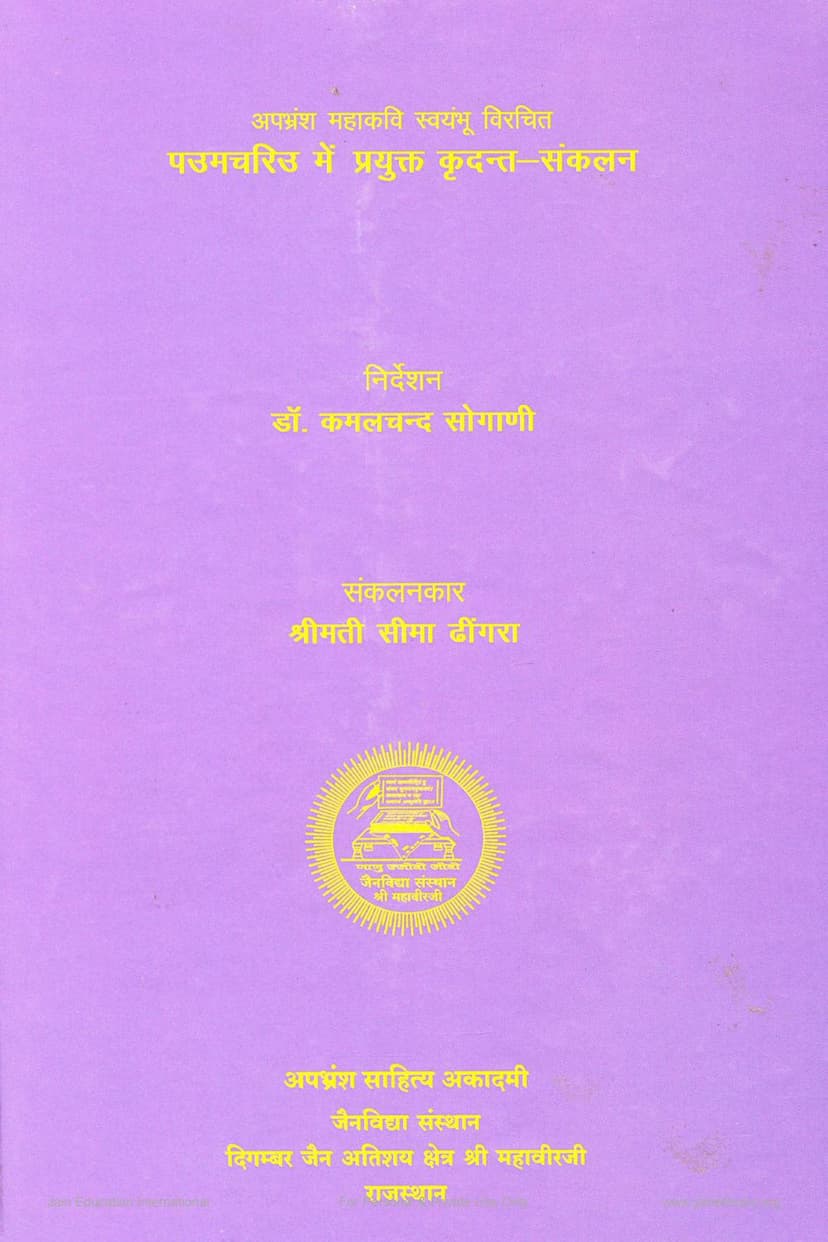Paumchariu Me Prayukta Krudant Sankalan
Added to library: September 2, 2025

Summary
This document is a comprehensive compilation and analysis of the kṛdanta (verbal participle) forms used in the Paumchariu, an epic poem composed by the renowned Apabhraṃśa poet Svayambhū.
Here's a breakdown of the book's content and purpose:
Title: Paumchariu me Prayukta Krudant Sankalan (Compilation of Kṛdantas Used in the Paumchariu)
Authors: Kamalchand Sogani, Seema Dhingara
Publisher: Apabhraṃśa Sahitya Academy, Jainvidya Sansthan, Shri Mahavirji, Rajasthan
Key Objectives and Content:
- Introduction to Apabhraṃśa: The book highlights the significance of Apabhraṃśa as the source language for many modern Indian languages, emphasizing its importance for historical linguistic studies and understanding Indian literature.
- Focus on Kṛdantas: The primary aim is to systematically present and explain the various kṛdantas found in the Paumchariu. The book explains that kṛdantas are crucial for understanding and appreciating literature, as they add beauty and nuance to language.
- Classification of Kṛdantas: The book categorizes the kṛdantas into five main types, based on their grammatical function and formation:
- Sambandhaka Kṛdanta (Relational Participle): Used when one action is completed before another. These are typically indeclinable (avyaya).
- Hetvarthaka Kṛdanta (Purpose Participle): Expresses purpose or "for the sake of" (e.g., "to laugh"). These are also indeclinable.
- Vartamāna Kṛdanta (Present Participle): Functions as an adjective, describing an ongoing action (e.g., "laughing"). Their forms change according to the gender and number of the noun they modify.
- Bhūtakālika Kṛdanta (Past Participle): Indicates a past action and also functions as an adjective. The book details both regular and irregular past participles.
- Vidhi Kṛdanta (Gerundive/Obligative Participle): Expresses obligation or necessity (e.g., "should be laughed"). These are used in passive or impersonal constructions.
- Detailed Analysis and Examples: For each category of kṛdanta, the book:
- Provides a definition and explanation of its usage.
- Lists the affixes (pratyayas) used to form them in Apabhraṃśa.
- Illustrates their use with numerous examples taken directly from the Paumchariu.
- Includes the grammatical breakdown (verb root + suffix) and the Hindi meaning of each example.
- Provides the specific reference (section, canto, line) from the Paumchariu for each example.
- Intransitive and Transitive Verbs: The compilation distinguishes between kṛdantas formed from intransitive (akarmak) and transitive (sakarmak) verbs, noting any specific grammatical requirements (like the mandatory presence of an object with transitive verbs).
- Inflectional Usage: For present participles, the book demonstrates how their forms change with different case endings (vibhakti) and genders/numbers.
- Causative Forms (Preraṇārthaka): The book also discusses the causative forms of kṛdantas, where the action is performed by someone else through instigation.
- Appendices:
- Lists of intransitive and transitive verbs used in forming the kṛdantas.
- A bibliography of supporting books and dictionaries.
Significance of the Book:
This book serves as an invaluable resource for students, scholars, and anyone interested in the Apabhraṃśa language and its rich literary heritage, particularly the Paumchariu. It systematically demystifies the complex grammar of verbal participles in a classical Apabhraṃśa text, making the Paumchariu more accessible and understandable. The detailed compilation and referencing ensure accuracy and depth in the study of Apabhraṃśa linguistics and literature.